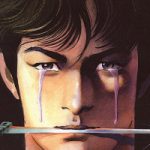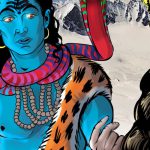Lone Wolf and Cub
Regions: Japan

Originally published in Japan as Kozure ōkami, Lone Wolf and Cub is a samurai epic manga series created by writer Kazuo Koike and artist Gōseki Kojima. Set in the feudal period of Japan (ca. 17th century), this series chronicles the journey of the protagonist samurai, Ittō Ogami, and his toddler son, Daigorō, who seek vengeance on the Ura-Yagū (Shadow Yagū) clan that murdered Ogami’s family and servants. Serialized first in a seinen (young men) manga magazine Manga Action by Futabasha (1970-1976), it became widely popular in Japan, exemplified by several films, TV drama, and video game adaptations from the 1970s to the 2000s. This saga, which amounts to more than 8,000 pages in total, has been translated into English, published partially by First Comics (1987-1991) and in whole by Dark Horse Comics (2000-2002).
The main narrative of Lone Wolf and Cub focuses on the protagonist Ittō Ogami who has a highly skilled swordsmanship. Under the direction of Retsudō Yagū, the mastermind of Ura-Yagū clan, who aims to extend its power over the government, Ogami’s wife and servants are slaughtered by the assassins sent by Retsudō. Ogami furthermore is stripped of the high-ranked position of kaishakunin (executioner) of the Tokugawa Shogunate. Vowing revenge on the Yagū clan, Ogami has decided to take a path of meifumadō (“Road to Hell”) with his survived toddler son, wandering different places of feudal Japan where he sells his services as a skilled swordsman as a hired assassin. After Ogami and his son set off on their journey, the majority of the series is comprised of a series of self-contained episodes that involve human drama, particularly the relationship between father and son, embellished with action-filled fighting scenes with local lords, gangs, and the ninja assassins sent by the Yagū. The last volume depicts a fierce battle between Ogami and his archenemy Retsudō Yagū in which Ogami dies, but his son Daigorō succeeds in killing Retsudō by plunging his furious spear into his body.
Along with Koike’s deftly composed scripts, Lone Wolf and Cub is also celebrated for its visual artwork by Gōseki Kojima. Kojima often uses brushes (instead of pens) to create lines to express motion and to depict backgrounds, to create dark and dramatic effects. The sophisticated use of cinematic techniques (e.g. mise en scène, aspect-to-aspect transition, and framing) also serve as suggestive, symbolic, and sometimes lyrical means of graphic storytelling, as exemplified by several instances in which stories are conveyed by visuals only without words.
Lone Wolf and Cub is influential both domestically and internationally. In North America, it has influenced several comics artists; most famously, Frank Miller, who played a major role in bringing the series to English-language readers, drew several front cover images of English volumes. It is often pointed out that his graphic novels such as Ronin (1983-1984) and Sin City (1991-2000) exhibit influences from Lone Wolf and Cub. American comics artist Max Allan Collins’ 1998 graphic novel Road to Perdition with art by Richard Piers Rayner is clearly inspired by Lone Wolf and Cub—transposed the original narrative into a 1970s’ gang noir setting, carrying an epigram taken from Kazuo Koike: “You must choose a road for yourself.” In 2004, Kazuo Koike and Gōseki Kojima won the Hall of Fame Eisner Award.
— Shige (CJ) Suzuki
Further Reading
- Köhn, Stephan. 2006. “Glimpses of the Past: The Allegedly Authentic Samurai Spirit as Seen through Kozure ōkani (Lone Wolf and Cub).” In Reading Manga: Local and Global Perceptions of Japanese Comics, edited by Jaqueline Berndt and Steffi Richter, 127–146. Leipzig: Leipzig University.
- Lefèvre, Pascal. 2011. “Formal Analysis. Mise en scène and framing in Lone Wolf and Cub.” In Critical Approaches to Comics: Theories and Methods, edited by Randy Duncan and Matthew J. Smith, 71-83. Routledge.
- Shamoon, Deborah. 2011. “Film on Paper: Cinematic Narrative in Gekiga” In Mangatopia: Essays on Manga and Anime in the Modern World, edited by Timothy Perper and Martha Cornog, 21-36. Santa Barbara, CA: Libraries Unlimited.


